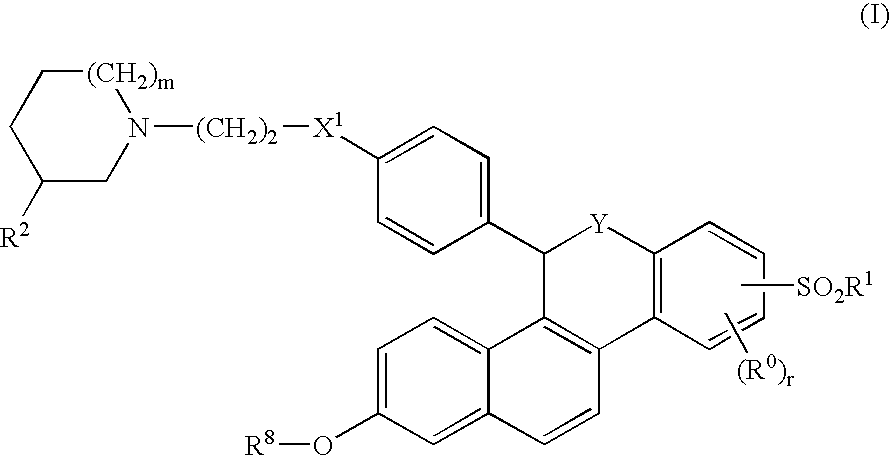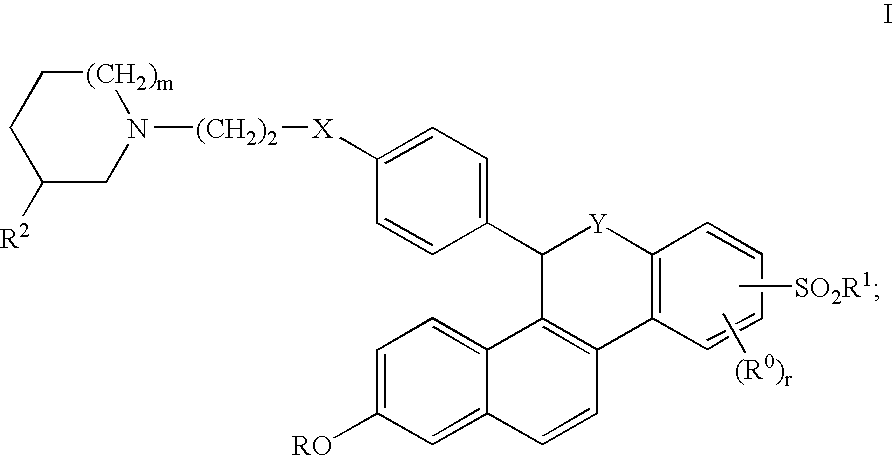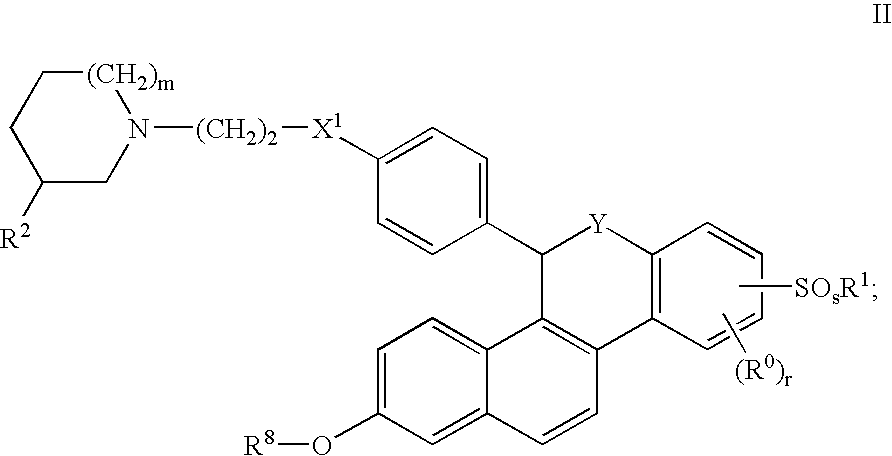Selective Estrogen Receptor Modulators
a technology of estrogen receptor and selective estrogen, applied in the field of medicine, can solve the problems of dysmenorrhea and infertility in women, and the actual use of serm compounds, especially in pre-menopausal women, has been hampered
- Summary
- Abstract
- Description
- Claims
- Application Information
AI Technical Summary
Problems solved by technology
Method used
Image
Examples
preparation 1
1-Bromo-2-isopropoxy-4-methylthio-benzene
[0069]
[0070]Add 2-Bromopropane (6.0 mL, 0.062 mol, Aldrich) and potassium carbonate (21.0 g, 0.156 mol) to a solution of 2-bromo-5-fluorophenol (10.0 g, 0.052 mol) in 80 mL of acetone. Heat the mixture in a 70° C. oil bath, and stir under reflux for 17 hours. Remove the solvents in vacuo, add 200 mL water, and extract the mixture 3 times with dichloromethane. Dry the combined organic layers over Na2SO4, and evaporate the solvents in vacuo.
[0071]Dissolve the residue (5.0 g, 21.45 mmol) in 25 mL of dimethylformamide (DMF) at room temperature. Add NaSCH3 (1.87 g, 26.81 mmol) all at once. Fit the reaction vessel with a reflux condenser then heat to 60° C. with stirring for 2 hours. Cool the reaction to room temperature, then add 50 mL of H2O, and extract the mixture 3 times with dichloromethane. Combine the organics, dry over Na2SO4 and remove the solvents in vacuo. Purify the residue by column chromatography on a 90 g SiO2 cartridge, using 5% et...
preparation 2
Trifluoromethanesulfonic acid 6-methoxy-1-[4-(2-piperidin-1-yl-ethoxy)-benzoyl]-naphthalen-2-yl ester
[0072]
[0073]Dissolve 2,6-dimethoxynaphthalene (1.0 equivalent (eq)) in CH2Cl2 (5 volume equivalents) at ambient temperature in a dry round bottom flask equipped with stir bar, temperature probe and N2 line. Cool the solution to 0° C. with an ice bath, and add 4-(2-piperidin-1-yl-ethoxy)-benzoyl chloride (1.1 eq). Add aluminum chloride (2.0 eq). Once the reaction is determined to be complete, quench the reaction slowly with 1 N NaOH and dilute with additional water and CH2Cl2. Wash the aqueous layer with CH2Cl2 (20 mL). Combine the organic extracts and wash with brine and dry (Na2SO4). Recrystallize the crude product from methanol to give (2,6-dimethoxy-naphthalen-1-yl)-[4-(2-piperidin-1-yl-ethoxy)-phenyl]-methanone.
[0074]Dissolve (2,6-dimethoxy-naphthalen-1-yl)-[4-(2-piperidin-1-yl-ethoxy)-phenyl]-methanone in CH2Cl2 (10 volume equivalents) in a 3-neck round bottom flask equipped wit...
preparation 3
[2-(2-Isopropoxy-4-methanesulfanyl-phenyl)-6-methoxy-naphthalen-1-yl]-[4-(2-piperidin-1-yl-ethoxy)-phenyl]-methanone
[0076]
[0077]Dissolve trifluoro-methanesulfonic acid 6-methoxy-1-[4-(2-piperidin-1-yl-ethoxy)-benzoyl]-naphthalen-2-yl ester (1.9 g, 3.18 mmol) in 30 mL acetonitrile, and degas 3 times. Add bis-neopentylglycolato diborane (789 mg, 3.51 mmol), palladium acetate (107 mg, 0.48 mmol) and tricyclohexyl phosphine (200 mg, 0.717 mmol) all at once, and again degas the mixture. Stir for 5 minutes to completely dissolve the reagents. Add cesium fluoride (4.3 g, 28.6 mmol) all at once, and immediately plunge the reaction vessel into a 90° C. preheated oil bath. After 2-3 minutes, add 1-bromo-2-isopropoxy-4-methanesulfanyl-benzene (0.915 g, 3.51 mmol) in 5 mL acetonitrile. After stirring at 90° C. for 20 minutes, cool the reaction, filter through a 2 g SiO2 plug, and remove the solvents in vacuo. Dilute the residue with dichloromethane (DCM) / isopropanol (i-PrOH) (4:1) (100 mL), was...
PUM
| Property | Measurement | Unit |
|---|---|---|
| enantiomeric excess | aaaaa | aaaaa |
| enantiomeric excess | aaaaa | aaaaa |
| enantiomeric excess | aaaaa | aaaaa |
Abstract
Description
Claims
Application Information
 Login to View More
Login to View More - R&D
- Intellectual Property
- Life Sciences
- Materials
- Tech Scout
- Unparalleled Data Quality
- Higher Quality Content
- 60% Fewer Hallucinations
Browse by: Latest US Patents, China's latest patents, Technical Efficacy Thesaurus, Application Domain, Technology Topic, Popular Technical Reports.
© 2025 PatSnap. All rights reserved.Legal|Privacy policy|Modern Slavery Act Transparency Statement|Sitemap|About US| Contact US: help@patsnap.com



